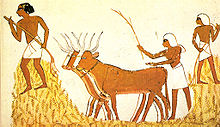Վիքիպեդիա:Նախագիծ:Թարգմանչի անկյուն/Անգլերեն/45
Գյուղատնտեսություն
Անգլերեն
Նեոլիթ

The Fertile Crescent of Western Asia first saw the domestication of animals, starting the Neolithic Revolution. Between 10,000 and 13,000 years ago, the ancestors of modern cattle, sheep, goats and pigs were domesticated in this area. The gradual transition from wild harvesting to deliberate cultivation happened independently in several areas around the globe. Agriculture allowed for the support of an increased population, leading to larger societies and eventually the development of cities. It also created the need for greater organization of political power (and the creation of social stratification), as decisions had to be made regarding labor and harvest allocation and access rights to water and land. Agriculture bred immobility, as populations settled down for long periods of time, which led to the accumulation of material goods.
Early Neolithic villages show evidence of the ability to process grain, and the Near East is the ancient home of the ancestors of wheat, barley and peas. There is evidence of the cultivation of figs in the Jordan Valley as long as 11,300 years ago, and cereal (grain) production in Syria approximately 9,000 years ago. During the same period, farmers in China began to farm rice and millet, using man-made floods and fires as part of their cultivation regimen. Fiber crops were domesticated as early as food crops, with China domesticating hemp, cotton being developed independently in Africa and South America, and the Near East domesticating flax. The use of soil amendments, including manure, fish, compost and ashes, appears to have begun early, and developed independently in several areas of the world, including Mesopotamia, the Nile Valley and Eastern Asia.

Squash was grown in Mexico nearly 10,000 years ago, while maize-like plants, derived from the wild teosinte, began to be seen at around 9,000 years ago. The derivation of teosinte into modern corn was slow, however, and it took until 5,500[10] to 6,000 years ago to turn into what we know today as maize. It then gradually spread across North America and was the major crop of Native Americans at the time of European exploration. Beans were domesticated around the same time, and together these three plants formed the Three Sisters nutritional foundation of many native populations in North and Central America. Combined with peppers, these crops provided a balanced diet for much of the continent. Grapes were first grown for wine approximately 8,000 years ago, in the Southern Caucasus, and by 3000 BC had spread to the Fertile Crescent, the Jordan Valley and Egypt.
Agriculture advanced to Europe slightly later, reaching the northeast of the continent from the east around 4000 BC. The idea that agriculture spread to Europe, rather than independently developing there, has led to two main hypotheses. The first is a "wave of advance", which holds that agriculture traveled slowly and steadily across the continent, while the second, "population pulse" theory, holds that it moved in jumps. Also around 6000 years ago, horses first began to be domesticated in the Eurasian steppes. Initially used for food, it was quickly discovered that they were useful for field work and carrying goods and people. Around 5,000 years ago, sunflowers were first cultivated in North America, while South America's Andes region was developing the potato. A minor center of domestication, the indigenous peoples of the eastern United States appear to have domesticated numerous crops, including tobacco.
| Թարգմանիչ | ||
| Վերստուգող |